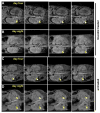Monitoring the inflammatory response to infection through the integration of MALDI IMS and MRI
- PMID: 22704626
- PMCID: PMC3377982
- DOI: 10.1016/j.chom.2012.04.018
Monitoring the inflammatory response to infection through the integration of MALDI IMS and MRI
Abstract
Systemic bacterial infection is characterized by a robust whole-organism inflammatory response. Analysis of the immune response to infection involves technologies that typically focus on single organ systems and lack spatial information. Additionally, the analysis of individual inflammatory proteins requires antibodies specific to the protein of interest, limiting the panel of proteins that can be analyzed. Herein we describe the application of matrix-assisted laser desorption/ionization imaging mass spectrometry (MALDI IMS) to mice systemically infected with Staphylococcus aureus to identify inflammatory protein masses that respond to infection throughout an entire infected animal. Integrating the resolution afforded by magnetic resonance imaging (MRI) with the sensitivity of MALDI IMS provides three-dimensional spatially resolved information regarding the distribution of innate immune proteins during systemic infection, allowing comparisons to in vivo structural information and soft-tissue contrast via MRI. Thus, integrating MALDI IMS with MRI provides a systems-biology approach to study inflammation during infection.
Copyright © 2012 Elsevier Inc. All rights reserved.
Conflict of interest statement
The authors have no conflicts of interest to report.
Figures





Comment in
-
Inflammation in 3D.Cell Host Microbe. 2012 Jun 14;11(6):557-9. doi: 10.1016/j.chom.2012.05.006. Cell Host Microbe. 2012. PMID: 22704615
Similar articles
-
Integrating spatially resolved three-dimensional MALDI IMS with in vivo magnetic resonance imaging.Nat Methods. 2008 Jan;5(1):57-9. doi: 10.1038/nmeth1147. Epub 2007 Dec 16. Nat Methods. 2008. PMID: 18084298 Free PMC article.
-
Exploring three-dimensional matrix-assisted laser desorption/ionization imaging mass spectrometry data: three-dimensional spatial segmentation of mouse kidney.Anal Chem. 2012 Jul 17;84(14):6079-87. doi: 10.1021/ac300673y. Epub 2012 Jul 5. Anal Chem. 2012. PMID: 22720760
-
Inflammation in 3D.Cell Host Microbe. 2012 Jun 14;11(6):557-9. doi: 10.1016/j.chom.2012.05.006. Cell Host Microbe. 2012. PMID: 22704615
-
Imaging mass spectrometry for lipidomics.Biochim Biophys Acta. 2011 Nov;1811(11):961-9. doi: 10.1016/j.bbalip.2011.03.004. Epub 2011 Mar 29. Biochim Biophys Acta. 2011. PMID: 21440085 Review.
-
MALDI imaging mass spectrometry: molecular snapshots of biochemical systems.Nat Methods. 2007 Oct;4(10):828-33. doi: 10.1038/nmeth1094. Nat Methods. 2007. PMID: 17901873 Review.
Cited by
-
Molecular analysis of model gut microbiotas by imaging mass spectrometry and nanodesorption electrospray ionization reveals dietary metabolite transformations.Anal Chem. 2012 Nov 6;84(21):9259-67. doi: 10.1021/ac302039u. Epub 2012 Oct 10. Anal Chem. 2012. PMID: 23009651 Free PMC article.
-
Matrix-assisted laser desorption ionization imaging mass spectrometry: in situ molecular mapping.Biochemistry. 2013 Jun 4;52(22):3818-28. doi: 10.1021/bi301519p. Epub 2013 Jan 16. Biochemistry. 2013. PMID: 23259809 Free PMC article. Review.
-
MicroLESA: Integrating Autofluorescence Microscopy, In Situ Micro-Digestions, and Liquid Extraction Surface Analysis for High Spatial Resolution Targeted Proteomic Studies.Anal Chem. 2019 Jun 18;91(12):7578-7585. doi: 10.1021/acs.analchem.8b05889. Epub 2019 May 31. Anal Chem. 2019. PMID: 31149808 Free PMC article.
-
High-resolution MALDI mass spectrometric imaging of lipids in the mammalian retina.Histochem Cell Biol. 2015 May;143(5):453-62. doi: 10.1007/s00418-014-1303-1. Epub 2014 Dec 23. Histochem Cell Biol. 2015. PMID: 25534592
-
Metabolic crosstalk between host and pathogen: sensing, adapting and competing.Nat Rev Microbiol. 2016 Apr;14(4):221-34. doi: 10.1038/nrmicro.2016.12. Epub 2016 Mar 7. Nat Rev Microbiol. 2016. PMID: 26949049 Review.
References
-
- Andersson M, Groseclose MR, Deutch AY, Caprioli RM. Imaging mass spectrometry of proteins and peptides: 3D volume reconstruction. Nature Methods. 2008;5:101–108. - PubMed
-
- Corbin BD, Seeley EH, Raab A, Feldmann J, Miller MR, Torres VJ, Anderson KL, Dattilo BM, Dunman PM, Gerads R, et al. Metal Chelation and Inhibition of Bacterial Growth in Tissue Abscesses. Science. 2008;319:962–965. - PubMed
Publication types
MeSH terms
Grants and funding
LinkOut - more resources
Full Text Sources
Other Literature Sources
Medical

